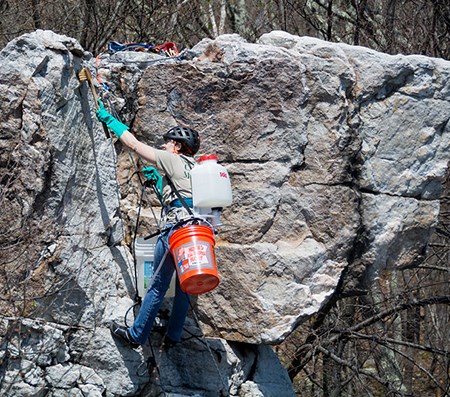Last updated: October 15, 2021
Article
Preserving Natural Treasures: Removing Graffiti from Wolf Rock at Catoctin Mountain Park

NPS Photo
A gem of the park is Wolf Rock, aptly named for the rock formation’s resemblance to the head of a wolf. One of the last things a park visitor expects to see while hiking through the natural landscape is spray painted graffiti. Unfortunately, until recently, this is exactly what park visitors encountered when they hiked past Wolf Rock.

Courtesy of John Zuke
Understanding the mineral composition of Wolf Rock was helpful when it came time to develop a plan to remove the graffiti from the rock. The ultimate goal was to remove the graffiti from the stone as safely as possible while protecting the natural resources and preserving views. Safety was a particular concern because the graffiti was located 20 feet off the ground and could only be accessed with the use of rock climbing equipment and trained climbers.
As early as the 1870s, the area along the Catoctin ridge became a popular hiking location to take in the spectacular views from Wolf Rock and nearby Chimney Rock. Until recently, rock climbing and bouldering were prohibited in the park. In 2016, the Mid-Atlantic Climbers (MAC), a non-profit organization dedicated to preserving access to climbing areas in the Mid-Atlantic region, worked with the Access Fund and Catoctin Mountain Park to open the park to bouldering, a popular form of rock climbing that is performed without the use of ropes or harnesses. Bouldering is now allowed throughout the park, and technical roped climbing is allowed at Wolf Rock.
This partnership between the rock climbing community and the National Park Service led Catoctin Mountain Park to host the 2017 Mid-Atlantic Climbers Adopt-a-Crag event, where volunteers worked with park staff in caring for climbing areas in the park. With this relationship in place, the park recalled the climbing group to access and eventually implement the graffiti removal project at Wolf Rock in April of 2018.
As early as the 1870s, the area along the Catoctin ridge became a popular hiking location to take in the spectacular views from Wolf Rock and nearby Chimney Rock. Until recently, rock climbing and bouldering were prohibited in the park. In 2016, the Mid-Atlantic Climbers (MAC), a non-profit organization dedicated to preserving access to climbing areas in the Mid-Atlantic region, worked with the Access Fund and Catoctin Mountain Park to open the park to bouldering, a popular form of rock climbing that is performed without the use of ropes or harnesses. Bouldering is now allowed throughout the park, and technical roped climbing is allowed at Wolf Rock.
This partnership between the rock climbing community and the National Park Service led Catoctin Mountain Park to host the 2017 Mid-Atlantic Climbers Adopt-a-Crag event, where volunteers worked with park staff in caring for climbing areas in the park. With this relationship in place, the park recalled the climbing group to access and eventually implement the graffiti removal project at Wolf Rock in April of 2018.

Courtesy of John Zuke
The project was challenging to organize because of the location of Wolf Rock and the nature of the work to be performed. Once the rock climbing access ropes were set up and all safety procedures were in place, the graffiti was sequentially removed from each elevation of Wolf Rock. By the end of the day the climbers had removed all traces of the spray painted graffiti using a solvent-based paint stripper, scrub brushes, and a backpack water pump sprayer. The project was a successful example of multiple groups coming together to restore Wolf Rock to its natural condition in order to improve the scenic views of this iconic feature.
[1] “Nature.” National Park Service, U.S. Department of the Interior, 2017, https://www.nps.gov/cato/learn/nature/index.htm
[2] “Geology.” National Park Service, U.S. Department of the Interior, 2016, https://www.nps.gov/cato/learn/nature/geology.htm
This article was contributed by Lindy Gulick, National Capital Region Architectural Conservator.
Unless otherwise noted, photos are courtesy of John Zuke, a member of the Mid-Atlantic Climbers organization.




